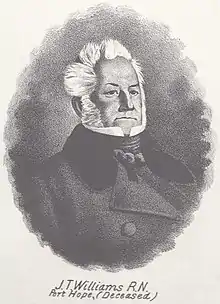Durham (Province of Canada electoral district)
Durham was an electoral district of the Legislative Assembly of the Parliament of the Province of Canada, in Canada West, on the north shore of Lake Ontario. It was created in 1841, upon the establishment of the Province of Canada by the union of Upper Canada and Lower Canada. Durham was represented by one member in the Legislative Assembly. It was abolished in 1867, upon the creation of Canada and the province of Ontario.
| Defunct pre-Confederation electoral district | |
|---|---|
| Legislature | Legislative Assembly of the Province of Canada |
| District created | 1841 |
| District abolished | 1867 |
| First contested | 1841 |
| Last contested | 1863 |
Boundaries
Durham electoral district was based on Durham County, on the north shore of Lake Ontario, in Canada West (now the province of Ontario), east of what is now Toronto. Oshawa and Port Hope were two of the main towns.
The Union Act, 1840 had merged the two provinces of Upper Canada and Lower Canada into the Province of Canada, with a single Parliament. The separate parliaments of Lower Canada and Upper Canada were abolished.[1] The Union Act provided that the pre-existing electoral boundaries of Upper Canada would continue to be used in the new Parliament, unless altered by the Union Act itself.[2]
Durham County had been an electoral district in the Legislative Assembly of Upper Canada,[3] and its boundaries were not altered by the Act. Those boundaries had been initially been set by the first Lieutenant Governor of Upper Canada, John Graves Simcoe, in 1792:
The boundaries were further defined by a statute of Upper Canada in 1798, and modified by an additional statute in 1834:
In 1834, the townships of Verulam, Fenelon and Eldon were added to Durham County.[6]
Since Durham was not changed by the Union Act, those boundaries continued to be used for the new electoral district.
Members of the Legislative Assembly
Durham was represented by one member in the Legislative Assembly.[2] The following were the members for Durham.
| Parliament | Years | Member[7] | Party[8] | |
|---|---|---|---|---|
| 1st Parliament 1841–1844 |
1841–1844 | John Tucker Williams |  |
Unionist; Reformer, then Independent |
Abolition
The district was abolished on July 1, 1867, when the British North America Act, 1867 came into force, creating Canada and splitting the Province of Canada into Quebec and Ontario.[9] It was split into two electoral districts at both the federal level and the provincial level: Durham East and Durham West in the House of Commons of Canada,[10] Durham East and Durham West in the Legislative Assembly of Ontario.[11]
References
- Union Act, 1840, 3 & 4 Vict., c. 35, s. 2.
- Union Act, 1840, s. 16.
- Journal of the House of Assembly of Upper Canada, from the eighth day of November, 1836, to the fourth day of March, 1837, p. 15 (November 8, 1836).
- Proclamation, Lieutenant Governor Simcoe, July 16, 1792; reprinted Statutes of the Province of Upper Canada; Together with Such British Statutes, Ordinances of Quebec, and Proclamations, as Relate to the Said Province (Kingston: F. M. Hill., 1831) p. 24.
- An act for the Better Division of this Province, SUC 1798, c. 5, s. 20. Reprinted in The Statutes of Upper Canada to the Time of Union, Revised and Published by Authority, Vol. I - Public Acts (Toronto: Robert Stanton, Queen's Printer, 1843).
- An Act to attach certain Townships in the District of Newcastle to the Counties of Northumberland and Durham, respectively, SUC 1834, c. 15.
- J.O. Côté, Political Appointments and Elections in the Province of Canada, 1841 to 1860, (Quebec: St. Michel and Darveau, 1860), pp. 43-58.
- For party affiliations, see Paul G. Cornell, Alignment of Political Groups in Canada, 1841-67 (Toronto: University of Toronto Press, 1962; reprinted in paperback 2015), pp. 93-111.
- British North America Act, 1867 (now the Constitution Act, 1867), s. 6.
- Constitution Act, 1867, s. 40, para. 2
- Constitution Act, 1867, s. 70.
![]() This article incorporates text from this source, which is in the public domain: Proclamation, Lieutenant Governor John Graves Simcoe, July 16, 1792
This article incorporates text from this source, which is in the public domain: Proclamation, Lieutenant Governor John Graves Simcoe, July 16, 1792
![]() This article incorporates text from this source, which is in the public domain: An act for the Better Division of this Province, SUC 1798, c. 5.
This article incorporates text from this source, which is in the public domain: An act for the Better Division of this Province, SUC 1798, c. 5.